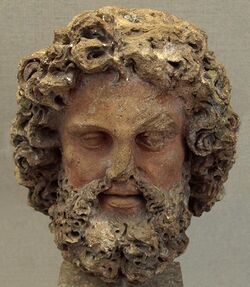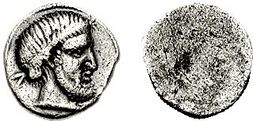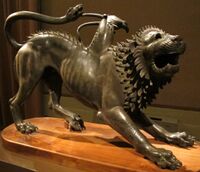Tinia
Topic: Religion
 From HandWiki - Reading time: 3 min
From HandWiki - Reading time: 3 min
| Tinia | |
|---|---|
God of the sky | |
 Terracotta bust of Tinia from 300–250 BCE | |
| Symbol | Thunderbolt |
| Personal information | |
| Consort | Uni |
| Children | Hercle and Menrva |
| Equivalents | |
| Greek equivalent | Zeus |
| Roman equivalent | Jupiter |
| Egyptian equivalent | Amun |
Tinia (also Tin, Tinh, Tins or Tina) was the god of the sky and the highest god in Etruscan mythology, equivalent to the Roman Jupiter and the Greek Zeus.[1] However, a primary source from the Roman Varro states that Veltha, not Tins, was the supreme deity of the Etruscans.[2] This has led some scholars to conclude that they were assimilated, but this is speculation.[3] He was the husband of Uni and the father of Hercle. Like many other Etruscan deities, his name is gender neutral.[4]
The Etruscans had a group of nine gods who had the power of hurling thunderbolts; they were called Novensiles by the Romans.[5] Of thunderbolts there were eleven sorts, of which Tinia wielded three.[5]
Tinia was sometimes represented with a beard or sometimes as youthful and beardless.[3] In terms of symbolism, Tinia has the thunderbolt.[3][4] Tinia's thunderbolts could be red or blood coloured.[6]
Like Selvans[3] and possibly Laran,[7] Tinia also protected boundaries. His name appears as the guarantor on three boundary stones with identical inscriptions found in Tunisia, originally placed there by the Etruscan colonists.[3]
Some of Tinia's possible epithets are detailed on the Piacenza Liver, a bronze model of a liver used for haruspicy. These inscriptions have been transcribed as Tin Cilens, Tin Θuf and Tinś Θne. There have been a number of suggestions as to their meaning, but the Etruscan language is poorly understood and there is no scholarly consensus for the translation.
Inscriptions
Tinia appears in several inscriptions, including:
- Kylix painted by Oltos (c. 500 BC):
- Itun turuce venel atelinas Tinas cliniiaras.
- This has given Venel Atelinas for the sons of Tin (ie: The Dioscuri[8])
- On the bronze Chimera of Arezzo:
- Tinscvil
- A gift to Tinia
See also
- Etruscan religion
- Etruscan civilization
- Uni
- Hercle
- Novensiles
References
- ↑ de Grummond, Etruscan Myth, Sacred History and Legend, page 53
- ↑ Varro, De lingua Latina V.46.
- ↑ 3.0 3.1 3.2 3.3 3.4 The Religion of the Etruscans. University of Texas Press. 2006.
- ↑ 4.0 4.1 The Etruscan World. Routledge. 2013. ISBN 978-0-415-67308-2.
- ↑ 5.0 5.1 Dennis, George (1848). The cities and cemeteries of Etruria: Vol.I. London.
- ↑ Nancy T. de Grummond, "Thunder versus Lightning in Etruria," Etruscan Studies, 2016, 19(2), 183-207.
- ↑ Konstantinos I. Soueref; Ariadni Gartziou-Tatti (2019). Gods of Peace and War in the Myths of the Mediterranean People. Ioannina, Greece: Ephorate of Antiquities of Ioannina - University of Ioannina. ISBN:978-960-233-247-4.
- ↑ Giuliano Bonfante and Larissa Bonfante (1983). The Etruscan language: an introduction. Manchester University Press. ISBN 9780719009020. https://archive.org/details/etruscanlanguage0000bonf.
 |
 KSF
KSF


